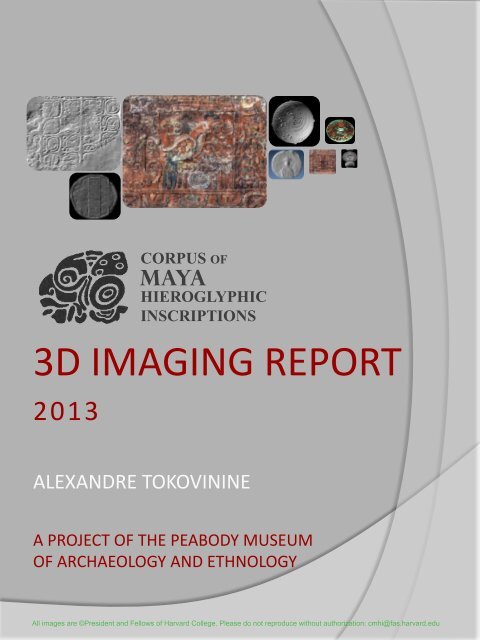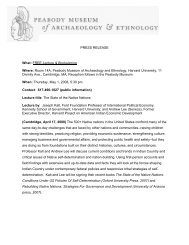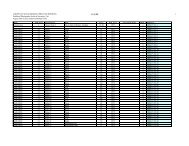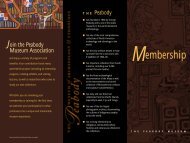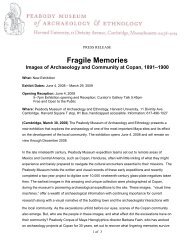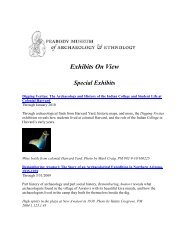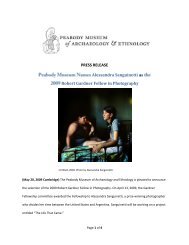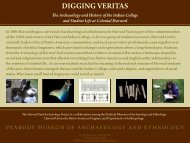3D IMAGING REPORT - Peabody Museum - Harvard University
3D IMAGING REPORT - Peabody Museum - Harvard University
3D IMAGING REPORT - Peabody Museum - Harvard University
You also want an ePaper? Increase the reach of your titles
YUMPU automatically turns print PDFs into web optimized ePapers that Google loves.
<strong>3D</strong> <strong>IMAGING</strong> <strong>REPORT</strong><br />
2013<br />
CORPUS OF<br />
MAYA<br />
HIEROGLYPHIC<br />
INSCRIPTIONS<br />
ALEXANDRE TOKOVININE<br />
A PROJECT OF THE PEABODY MUSEUM<br />
OF ARCHAEOLOGY AND ETHNOLOGY<br />
All images are ©President and Fellows of <strong>Harvard</strong> College. Please do not reproduce without authorization: cmhi@fas.harvard.edu
INTRODUCTION<br />
The Corpus of Maya Hieroglyphic<br />
Inscriptions (CMHI) leads the efforts to<br />
preserve and study the incredibly rich<br />
material heritage of the Maya civilization.<br />
The publications of the CMHI set the<br />
standard for the entire field of Maya<br />
studies.<br />
Finding ways to document and publish<br />
sculptures and inscriptions has been one<br />
of the main challenges in this endeavor.<br />
Techniques such as photography and<br />
drawing have been limited in their ability<br />
to record three-dimensional data. Making<br />
paper or latex molds of monuments may<br />
damage the surfaces, which are often<br />
highly fragile because of erosion. As<br />
molds cannot be stored long term, casts<br />
have to be made. Such plaster casts are<br />
often heavy, bulky, and also fragile, so<br />
their storage and use present additional<br />
logistical and conservation difficulties.<br />
This is why the CMHI has embraced the<br />
technology of three-dimensional (<strong>3D</strong>)<br />
digitization. The <strong>3D</strong> models produced are<br />
an invaluable tool for controlling the<br />
lighting and studying minute details that<br />
are difficult to see with the naked eye.<br />
Furthermore, digital <strong>3D</strong> scanning has<br />
several advantages over plaster casts: the<br />
recording process does not require direct<br />
contact with the object, therefore avoiding<br />
further damage; it is easier and cheaper to<br />
store, move, share, and study digital data;<br />
and it is still possible to make full physical<br />
replicas from the digital models.<br />
After several trials, the CMHI staff felt that<br />
the available <strong>3D</strong> digitization tools and<br />
software were accessible and efficient<br />
enough for use in the field. Once<br />
the photogrammetric <strong>3D</strong>-digitization<br />
system was acquired in the summer of<br />
2008, the <strong>3D</strong>-documentation project<br />
began.<br />
From 2008 to 2012, the Project focused<br />
largely on the documentation of the huge<br />
Hieroglyphic Stairway at the UNESCO<br />
World Heritage archaeological site of<br />
Copan, Honduras. The on-going<br />
deterioration of this highly important<br />
monument made such documentation a<br />
top priority. Non-contact digitization was<br />
preferable because the surfaces of the<br />
stairway blocks and sculptures were too<br />
fragile for making conventional molds.<br />
Moreover, digitization would allow<br />
scholars to create a new virtual<br />
reconstruction of the stairway, which<br />
could then be reproduced in some<br />
physical media. The <strong>3D</strong> project also<br />
recorded other monuments and artifacts<br />
at Copan with preference given to<br />
vulnerable objects which could not be<br />
documented by other means. In addition<br />
to the Stairway, the Project worked with<br />
collections of the National <strong>Museum</strong> of<br />
Archaeology and Ethnology of<br />
Guatemala, Metropolitan <strong>Museum</strong> of Art,<br />
<strong>Peabody</strong> <strong>Museum</strong> of Archaeology and<br />
Ethnology, Dumbarton Oaks, as well as at<br />
the archaeological sites of Quirigua,<br />
Holmul, La Sufricaya, and Yaxchilan.<br />
This report was compiled to present the<br />
scope and principal results of the <strong>3D</strong><br />
scanning project of the CMHI. The work<br />
has been carried out by the author in<br />
collaboration with CMHI director, Barbara<br />
Fash, from July 2008 to present. If you are<br />
interested in obtaining <strong>3D</strong> models or<br />
images from the project or have further<br />
questions, please contact us at:<br />
cmhi@fas.harvard.edu<br />
All images are ©President and Fellows of <strong>Harvard</strong> College. Please do not reproduce without authorization: cmhi@fas.harvard.edu<br />
1
ACKNOWLEDGMENTS<br />
The 3-D scanning project of the Corpus of Maya Hieroglyphic Inscriptions at the <strong>Peabody</strong><br />
<strong>Museum</strong> of Archaeology and Ethnology at <strong>Harvard</strong> <strong>University</strong> would like to thank a<br />
number of institutions, projects, and individuals for their support and assistance that made<br />
the work presented here possible.<br />
Banco Santander/Fundación Botín Fund for the Research and Conservation of Maya<br />
Sculpture<br />
David Rockefeller Center for Latin American Studies, <strong>Harvard</strong> <strong>University</strong><br />
Dumbarton Oaks Research Library and Collection<br />
Fundación Uno<br />
<strong>Harvard</strong> Art <strong>Museum</strong>s<br />
<strong>Harvard</strong> Center Shanghai<br />
<strong>Harvard</strong> China Fund<br />
Instituto de Antropología e Historia de Guatemala<br />
Instituto de Antropología e Historia de México<br />
Instituto Hondureño de Antropología e Historia<br />
Museo Nacional de Arqueología y Etnología, Guatemala<br />
<strong>Peabody</strong> <strong>Museum</strong> of Archaeology and Ethnology, <strong>Harvard</strong> <strong>University</strong><br />
Proyecto Arqueológico Holmul and Iniciativa de Arqueología Maya<br />
Proyecto Arqueológico El Zotz<br />
Semitic <strong>Museum</strong>, <strong>Harvard</strong> <strong>University</strong><br />
Smithsonian <strong>Museum</strong> Conservation Institute<br />
The Metropolitan <strong>Museum</strong> of Art<br />
Universidad Nacional Autónoma de México/Coordinación de Difusión Cultural<br />
<strong>University</strong> of Pennsylvania <strong>Museum</strong> of Archaeology and Anthropology<br />
World Monuments Fund<br />
The 3-D scanning team in Honduras:<br />
Adelso Canan<br />
César Martínez<br />
Erasmo Ramírez<br />
Harold Caballero<br />
Assistants to the Honduran scanning team:<br />
Juan Ramon Guerra<br />
Rufino Membreño<br />
The 3-D scanning team at <strong>Harvard</strong> <strong>University</strong>:<br />
Lauren Santini<br />
Steven Quinchia<br />
All images are ©President and Fellows of <strong>Harvard</strong> College. Please do not reproduce without authorization: cmhi@fas.harvard.edu<br />
2
DIGITIZING EQUIPMENT<br />
A structured light scanner like smartSCAN<br />
<strong>3D</strong> used by the CMHI project consists of a<br />
projector and two cameras mounted on a<br />
carbon fiber rod. The cameras and the<br />
projector are at an angle to each other<br />
and the operating distance from the<br />
scanned surface is fixed at 70cm. The<br />
system projects a sequence of patterns<br />
onto the object, while the cameras<br />
simultaneously record the surface. The<br />
distortion of the patterns caused by the<br />
surface is analyzed by the connected<br />
software that generates a <strong>3D</strong> point cloud<br />
from the pixels of the digital images.<br />
Texture (color) value is assigned to each<br />
point from the same cameras. Each<br />
successive scan is semi-automatically<br />
aligned to the rest of the data in real time.<br />
The CMHI chose this scanner model for<br />
its speed, resolution, accuracy, and<br />
portability. The light weight of the scanner<br />
(4kg) and its relatively faithful recording of<br />
color were also important. Another<br />
significant advantage was that the size of<br />
the scanned area or field of view (FOV)<br />
and the X.Y resolution (smallest distance<br />
between any two points in a single scan)<br />
could be altered by using different lens<br />
kits. The CMHI acquired three sets of<br />
lenses: 600mm FOV, X.Y resolution of<br />
0.36mm for larger monuments; 300mm<br />
FOV, X.Y resolution of 0.18mm for most<br />
objects; 90mm FOV, X.Y resolution of<br />
0.05mm for small and/or exceptionally<br />
detailed artifacts. Different resolutions<br />
may be combined during a single<br />
scanning project.<br />
All images are ©President and Fellows of <strong>Harvard</strong> College. Please do not reproduce without authorization: cmhi@fas.harvard.edu<br />
3
SCANNING TEAM<br />
In the controlled conditions of an office or<br />
a museum storage setting, it is possible to<br />
operate the scanner and the software with<br />
just one person. Field conditions and use<br />
of bulky additional equipment, such as a<br />
camera crane pictured to the right,<br />
however, necessitate larger working<br />
crews. Usually, at least two persons are<br />
required to move the tripod or crane and<br />
to point the camera, and an additional<br />
person is needed to operate the software.<br />
The latter role implies some prior training<br />
because it involves monitoring capture<br />
settings (shutter speed, gain, number of<br />
captures and averaging) which may<br />
change depending on the angle of the<br />
shot, surface texture, and the amount of<br />
ambient light. The operator also needs to<br />
assist the software to align the scans by<br />
manually pointing to the approximate<br />
areas of the overlap between successive<br />
captures.<br />
During fieldwork in Guatemala and<br />
Honduras, the project relied on the<br />
assistance from Harold Caballero, Adelso<br />
Canan, Erasmo Ramírez, and César<br />
Martínez. Adelso Canan’s contribution as<br />
a software operator was particularly<br />
significant. <strong>3D</strong> scanning on <strong>Harvard</strong>’s<br />
campus has been assisted by Lauren<br />
Santini and Steven Quinchia who took<br />
turns at operating the scanner and the<br />
software. <strong>Museum</strong> curators at Dumbarton<br />
Oaks and the Guatemalan National<br />
<strong>Museum</strong> of Archaeology and Ethnology<br />
(MUNAE) also provided valuable help with<br />
access to the objects.<br />
All images are ©President and Fellows of <strong>Harvard</strong> College. Please do not reproduce without authorization: cmhi@fas.harvard.edu<br />
4
LIST OF SCANNED OBJECTS<br />
COPAN<br />
Hieroglyphic Stairway (HS)<br />
Hieroglyphic Stairway MSC<br />
Xukpi step<br />
Yehnal stucco panel<br />
Margarita stucco panel<br />
Rosalila step<br />
Structure 11-sub step<br />
Ante step<br />
Stela 63<br />
Motmot marker<br />
‘Dazzler’ vessel<br />
body (CPN C1523)<br />
lid (CPN C1530)<br />
Rosalila ‘eccentric flints’<br />
(CPN P2706)<br />
(CPN P2707)<br />
(CPN P2759)<br />
(CPN P2760)<br />
(CPN P2761)<br />
(CPN P2762)<br />
(CPN P2763)<br />
(CPN P2764)<br />
(CPN P2765)<br />
RASTROJON, COPAN<br />
MSC stone block (CPN 29598)<br />
Human head (CPN 30101)<br />
PEABODY MUSEUM & HARVARD<br />
Copan HS blocks<br />
(93-27-20/C856)<br />
(93-27-20/C857)<br />
(93-27-20/C858)<br />
(93-27-20/C859&859A)<br />
(93-27-20/C861)<br />
(93-27-20/C862)<br />
(93-27-20/C865)<br />
(93-27-20/C866)<br />
(93-27-20/C867)<br />
Warrior figure from Copan HS<br />
shield (92-49-20/C842)<br />
head (93-27-20/871.2)<br />
headdress (95-42-20/C753)<br />
body (93-27-20/C871.1)<br />
Copan peccary skull (92-49-20/C201)<br />
Copan MSC sculpture (92-49-20/C74)<br />
Copan Altar F’ (92-49-20/C88)<br />
Piedras Negras Panel 2<br />
La Corona HS blocks<br />
(2003.32.1)<br />
(2003.32.2)<br />
Cast of Copan Altar Q (3093-27-20/C580)<br />
Cast of Tenochtitlan ‘Teocalli of the Sacred<br />
War’ (30-48-20/C11033)<br />
<strong>Harvard</strong> Tercentenary Stele<br />
Cuneiform tablet (SM # 1911-08-004)<br />
METROPOLITAN MUSEUM OF ART<br />
Tortuguero Monument 6 fragment<br />
DUMBARTON OAKS<br />
Byzantine coins<br />
(BZ.C.1948-17-2249)<br />
(BZ.C.2005-24)<br />
Byzantine bullae<br />
(BZ.C.1956-23-2909)<br />
(BZ.C.1961-20)<br />
Maya bone bells (PC.B.192A-D)<br />
Maya stone panel (PC.B.528)<br />
Maya stone panel (PC.B.537)<br />
Maya stone panel (PC.B.539)<br />
Maya/Olmec pendant (PC.B.538)<br />
Maya ceramic vessel (PC.B.554)<br />
HOLMUL<br />
Group 2 Building B-sub stucco frieze<br />
LA SUFRICAYA<br />
Stela 2 (carved area)<br />
Stela 5 (2 fragments)<br />
Stela 6 (carved area)<br />
QUIRIGUA<br />
Panel 1 (12 fragments)<br />
YAXCHILAN<br />
Stela 11 (front & sides)<br />
Lintel 29<br />
Structure 21 stucco frieze (part)<br />
HS 2 Step 7<br />
Stela 31 (part)<br />
All images are ©President and Fellows of <strong>Harvard</strong> College. Please do not reproduce without authorization: cmhi@fas.harvard.edu<br />
5
LIST OF SCANNED OBJECTS<br />
NATIONAL MUSEUM OF<br />
ARCHAEOLOGY AND ETHNOLOGY,<br />
GUATEMALA (MUNAE)<br />
El Zotz Lintel 1 (2 fragments)<br />
Tikal ‘Marker’<br />
Piedras Negras Panel 3<br />
Piedras Negras Panel 4<br />
Piedras Negras Panel 12<br />
Piedras Negras Panel 15<br />
Piedras Negras Stela 15<br />
All images are ©President and Fellows of <strong>Harvard</strong> College. Please do not reproduce without authorization: cmhi@fas.harvard.edu<br />
6
COPAN HIEROGLYPHIC STAIRWAY<br />
A milestone for the Project was the<br />
completion of the scanning of the<br />
Hieroglyphic Stairway, the longest known<br />
Maya text. The process required focused<br />
CMHI field operations for four years and<br />
was part of a research and conservation<br />
initiative in collaboration with the Instituto<br />
Hondureño de Antropología e Historia. A<br />
high-resolution digital record of the<br />
stairway will preserve this monument for<br />
future generations, facilitate further<br />
research on the hieroglyphic inscription,<br />
and reduce the necessity of direct access<br />
to the original.<br />
Only the first sixteen steps of the original<br />
63 of the Hieroglyphic Stairway were<br />
discovered in their original order (their <strong>3D</strong><br />
reconstruction in low resolution is pictured<br />
above). All stairway elements were<br />
scanned separately with the goal of reassembling<br />
them digitally in a new virtual<br />
reconstruction of the Stairway with the<br />
other blocks in close to their original<br />
order. The virtual reconstruction could<br />
then be reproduced using a <strong>3D</strong> printer or<br />
a milling machine.<br />
The carved frontal surfaces of Stairway<br />
blocks were scanned at the 0.18mm X.Y<br />
resolution and their plain tops were<br />
documented at the 0.36mm X.Y.<br />
resolution. Larger Stairway features such<br />
as the altar at its base, lower sections of<br />
the balustrades, and the figures of<br />
warriors were also scanned at 0.36mm.<br />
Each block and sculptural element<br />
constitutes a separate data set. Blocks<br />
are identified by their numbers. The<br />
warrior figures, the altar, and the<br />
balustrades have been assigned<br />
designations indicating their locations<br />
(Bottom Left/Right balustrades, altar,<br />
Figure 1 through 7 from the bottom up).<br />
All images are ©President and Fellows of <strong>Harvard</strong> College. Please do not reproduce without authorization: cmhi@fas.harvard.edu<br />
7
Each warrior figure decorating the<br />
Stairway has been scanned separately.<br />
There are six figures in total plus one at<br />
the <strong>Peabody</strong> <strong>Museum</strong>. Some of these<br />
figures which consist of multiple stone<br />
blocks may have been reconstructed<br />
incorrectly and would need a virtual ‘deconstruction’<br />
when a new digital model<br />
of the Stairway is assembled.<br />
All images are ©President and Fellows of <strong>Harvard</strong> College. Please do not reproduce without authorization: cmhi@fas.harvard.edu<br />
8
COPAN HIEROGLYPHIC STAIRWAY<br />
MISCELLANEOUS SCULPTURES<br />
Eighteen miscellaneous fragments of<br />
stairway blocks have been located in<br />
storage at the Regional Center of the<br />
Institute of Archaeology of Honduras<br />
(CRIA) and scanned at 0.18mm<br />
resolution. In addition to the blocks of<br />
the steps, seven fragments of serpent<br />
heads were scanned in 2012 at<br />
0.36mm resolution. Several more head<br />
fragments remained undocumented.<br />
The sculptures are currently located<br />
across the courtyard from the<br />
Hieroglyphic Stairway but were<br />
excavated in the 19th century from the<br />
stairway fall, and it is believed that<br />
they were originally associated with a<br />
terrace or platform on the upper<br />
section of the steps.<br />
All images are ©President and Fellows of <strong>Harvard</strong> College. Please do not reproduce without authorization: cmhi@fas.harvard.edu<br />
9
COPAN HIEROGLYPHIC STEPS<br />
Pictured here (from top to bottom) are<br />
hieroglyphic steps discovered in tunnel<br />
excavations from the Ante, Rosalila,<br />
Temple 11-Sub, and Xukpi structures at<br />
Copan scanned at 0.18mm resolution. A<br />
detail of Temple 11-Sub step is shown to<br />
the right. This monument suffered further<br />
damage a year after its scanning<br />
highlighting the urgency of such<br />
documentation.<br />
All images are ©President and Fellows of <strong>Harvard</strong> College. Please do not reproduce without authorization: cmhi@fas.harvard.edu<br />
10
COPAN STUCCO PANELS<br />
The stucco façade panels of buried<br />
Yehnal and Margarita structures were<br />
scanned at 0.36mm resolution in order to<br />
create a record of these unique and fragile<br />
monuments and to enable, if necessary,<br />
the production of <strong>3D</strong> replicas. A full-size<br />
<strong>3D</strong> replica of the Margarita panel (a detail<br />
of the replica is on the left) was recently<br />
made for the exhibition Maya 2012: Lords<br />
of Time at the <strong>University</strong> of Pennsylvania<br />
<strong>Museum</strong> of Archaeology and<br />
Anthropology.<br />
All images are ©President and Fellows of <strong>Harvard</strong> College. Please do not reproduce without authorization: cmhi@fas.harvard.edu<br />
11
MARGARITA PANEL<br />
Full color view and a detail without<br />
texture.<br />
All images are ©President and Fellows of <strong>Harvard</strong> College. Please do not reproduce without authorization: cmhi@fas.harvard.edu<br />
12
YEHNAL PANEL<br />
Full color view and a detail without<br />
texture.<br />
All images are ©President and Fellows of <strong>Harvard</strong> College. Please do not reproduce without authorization: cmhi@fas.harvard.edu<br />
13
COPAN MOTMOT MARKER AND<br />
STELA 63<br />
These Early Classic Copan<br />
monuments were scanned for the<br />
improvement of the current record and<br />
also for making physical replicas. The<br />
digital rendering and the <strong>3D</strong> print of the<br />
Motmot marker are pictured above.<br />
The front and one side of Stela 63 are<br />
on the left. Carved sections of these<br />
monuments were recorded at 0.18mm<br />
and plain areas at 0.36mm resolution.<br />
All images are ©President and Fellows of <strong>Harvard</strong> College. Please do not reproduce without authorization: cmhi@fas.harvard.edu<br />
14
DAZZLER VESSEL AND<br />
ECCENTRIC FLINTS FROM COPAN<br />
The goal of the <strong>3D</strong> documentation<br />
(0.18mm resolution) of the Dazzler and its<br />
lid was to facilitate the production of a<br />
replica. The model was intended for<br />
helping the artist, but not for <strong>3D</strong> printing.<br />
The slab feet and the bottom of the vessel<br />
were not fully recorded because that<br />
would be risky from a conservation<br />
standpoint (placing the vessel upsidedown).<br />
For the same reason, the inner<br />
side of the lid was not scanned. Nine<br />
eccentric flints from Rosalila cache have<br />
been recorded at 0.18mm resolution to<br />
enable their measurement, drawing, and<br />
study without endangering textile<br />
fragments adhering to the surface. Only<br />
one flint (CPN P2707) was scanned from<br />
just one side because it was sent on<br />
exhibit loan to the Penn <strong>Museum</strong> prior to<br />
finding a way to scan the other side. A<br />
scanning protocol that would not require<br />
turning the objects upside-down was<br />
developed to document the other flints.<br />
All images are ©President and Fellows of <strong>Harvard</strong> College. Please do not reproduce without authorization: cmhi@fas.harvard.edu<br />
15
SCULPTURE FROM RASTROJON<br />
A carved human head (CPN 30101)<br />
and a small carved stone block (CPN<br />
29598) from Structure 6N-10 at the<br />
archaeological site of Rastrojon were<br />
recorded at 0.36mm resolution. The<br />
miscellaneous stone block was<br />
documented as a test of the<br />
equipment in 2008. The reason for<br />
recording the head was its exceptional<br />
preservation. These pieces represent<br />
two of over 2000 sculptures that have<br />
been excavated from Structure 10 by<br />
the Proyecto Arqueológico Rastrojon<br />
Copan.<br />
All images are ©President and Fellows of <strong>Harvard</strong> College. Please do not reproduce without authorization: cmhi@fas.harvard.edu<br />
16
PEABODY MUSEUM: COPAN<br />
STAIRWAY FRAGMENTS<br />
Nine blocks (three pictured above)<br />
from the Copan Hieroglyphic Stairway<br />
in the collection of the <strong>Peabody</strong><br />
<strong>Museum</strong> since 1893, have been<br />
scanned at 0.18mm. Five sculptured<br />
pieces of the warrior figure from the<br />
stairway were scanned separately at<br />
0.36mm resolution and then reassembled<br />
digitally (right image).<br />
All images are ©President and Fellows of <strong>Harvard</strong> College. Please do not reproduce without authorization: cmhi@fas.harvard.edu<br />
17
PEABODY MUSEUM:<br />
COPAN MISCELLANEA<br />
The carved peccary skull from Copan in<br />
the <strong>Peabody</strong> <strong>Museum</strong> collection (pictured<br />
above) has been scanned at 0.05mm<br />
resolution. In addition to the peccary skull,<br />
an inscribed stone block (Altar F’) and a<br />
serpent head from Copan have been<br />
recorded at 0.36mm resolution. Some<br />
details of the Altar F' inscription may<br />
require additional documentation at<br />
0.18mm. Interactive <strong>3D</strong> views of the<br />
peccary skull are available online at:<br />
https://www.peabody.harvard.edu/node/822<br />
All images are ©President and Fellows of <strong>Harvard</strong> College. Please do not reproduce without authorization: cmhi@fas.harvard.edu<br />
18
PEABODY AND SEMITIC MUSEUM<br />
COLLECTIONS<br />
The CMHI <strong>3D</strong> project also scanned<br />
three monuments from Guatemala: the<br />
carved side of Panel 2 from Piedras<br />
Negras (pictured above) and two<br />
stairway blocks, which likely originated<br />
from the site of La Corona. Plain areas<br />
were documented at 0.18mm<br />
resolution. Carved sections were<br />
scanned at 0.05mm resolution<br />
because of the small dimensions of<br />
the carved details. The carved fronts<br />
of La Corona blocks were sawn off by<br />
the looters, so the <strong>3D</strong> models would<br />
allow to match the backs of the<br />
removed sections with the fronts of the<br />
blocks left at the site.<br />
In addition to carved and incised<br />
objects, the CMHI tested its high<br />
resolution (0.05mm) scanner setup on<br />
a tiny (30x32x12mm) cuneiform tablet<br />
from the Semitic <strong>Museum</strong> collections<br />
(#1911-08-004).<br />
All images are ©President and Fellows of <strong>Harvard</strong> College. Please do not reproduce without authorization: cmhi@fas.harvard.edu<br />
19
Piedras Negras Panel 2 color detail.<br />
All images are ©President and Fellows of <strong>Harvard</strong> College. Please do not reproduce without authorization: cmhi@fas.harvard.edu<br />
20
PEABODY MUSEUM PLASTER<br />
CASTS<br />
The XIX century plaster cast of Copan<br />
Altar Q (pictured above) was scanned<br />
at the resolution of 0.36mm to produce<br />
a physical replica on the basis of <strong>3D</strong><br />
data. Replicas, which retain more<br />
detail than the original monuments,<br />
became part of the exhibitions Maya<br />
2012: Lords of Time at the Penn<br />
<strong>Museum</strong> (pictured on the left), and<br />
Maya: Hidden Worlds Revealed<br />
premiering at the Science <strong>Museum</strong> of<br />
Minnesota in 2013.<br />
The cast of the “Teocalli of the Sacred<br />
War” from Tenochtitlan, Mexico, was<br />
scanned to test the 0.36mm resolution<br />
lens setup on a plaster cast and to<br />
explore the use of renderings (pictured<br />
to the left) and a <strong>3D</strong> PDF of the object<br />
in the classroom.<br />
All images are ©President and Fellows of <strong>Harvard</strong> College. Please do not reproduce without authorization: cmhi@fas.harvard.edu<br />
21
HARVARD TERCENTENARY STELE<br />
This marble monument was donated<br />
to <strong>Harvard</strong> <strong>University</strong> by the members<br />
of the <strong>Harvard</strong> Clubs of Nanking and<br />
Shanghai to mark the Tercentennial<br />
Ceremony at the university in 1936.<br />
Located outside the Widener Library,<br />
the stele has been exposed to acid<br />
rain and temperature/humidity<br />
fluctuations, which caused substantial<br />
erosion. The goal of <strong>3D</strong> scanning was<br />
to document the present state of the<br />
monument and to produce the data set<br />
that would allow a physical replica to<br />
be made. The original would then be<br />
relocated to a more protected setting.<br />
The stele was scanned at 0.36mm<br />
resolution. A higher resolution was not<br />
feasible because of the size of the<br />
monument. The project was carried<br />
out in collaboration with the <strong>Harvard</strong><br />
Center Shanghai, the <strong>Harvard</strong> China<br />
Fund, and the <strong>Harvard</strong> Art <strong>Museum</strong>s.<br />
All images are ©President and Fellows of <strong>Harvard</strong> College. Please do not reproduce without authorization: cmhi@fas.harvard.edu<br />
22
THE METROPOLITAN MUSEUM OF<br />
ART, NEW YORK<br />
The fragment of Monument 6 from<br />
Tortuguero, Mexico, in the collection of<br />
the Metropolitan <strong>Museum</strong> was<br />
scanned to assist in the Mexican<br />
Instituto Nacional de Antropología e<br />
Historia's reconstruction of the original<br />
monument. The <strong>3D</strong> data will be used<br />
to make a physical replica to be<br />
reunited with the rest of the stela in the<br />
museum in Tabasco, Mexico. The<br />
inscribed surface was scanned at<br />
0.05mm resolution and the plain areas<br />
were recorded at 0.18mm.<br />
All images are ©President and Fellows of <strong>Harvard</strong> College. Please do not reproduce without authorization: cmhi@fas.harvard.edu<br />
23
DUMBARTON OAKS<br />
BYZANTINE COINS AND SEALS<br />
Two golden Byzantine coins and two<br />
golden seals have been recorded at<br />
0.05mm resolution to test the<br />
feasibility of high-resolution scanning<br />
of these relatively shiny (but not highly<br />
polished) objects. Capturing the<br />
objects at oblique angles was<br />
successful where the surfaces proved<br />
to be too reflective for straight shots.<br />
Consequently, the color was not<br />
faithfully reproduced (as in the image<br />
above). Given that each object took<br />
one hour to scan and nearly an hour to<br />
process, scanning the whole collection<br />
was not feasible.<br />
All images are ©President and Fellows of <strong>Harvard</strong> College. Please do not reproduce without authorization: cmhi@fas.harvard.edu<br />
24
DUMBARTON OAKS<br />
BONE BELLS AND WING PENDANT<br />
A set of four Classic Maya bone bells<br />
in the Dumbarton Oaks collection were<br />
scanned at 0.05mm resolution. Only<br />
part of the interior surface could be<br />
documented due to visibility issues.<br />
Multiple renderings of the <strong>3D</strong> models<br />
of the bells were used for<br />
measurement and drawings in the<br />
catalog of the ancient Maya art at<br />
Dumbarton Oaks.<br />
The Olmec Wing Pendant with incised<br />
Pre-Classic Maya image and text was<br />
also scanned at 0.05mm resolution for<br />
the same project. The reflective and<br />
partially translucent surface of the<br />
artifact caused too much noise in the<br />
data. A noise reduction algorithm could<br />
not be applied because it would also<br />
largely erase the incised lines on the<br />
back of the pendant. Consequently,<br />
the <strong>3D</strong> model was not used as a<br />
source of the new line drawing of the<br />
pendant, although it is still of value for<br />
making measurements and crosssections<br />
of the object.<br />
All images are ©President and Fellows of <strong>Harvard</strong> College. Please do not reproduce without authorization: cmhi@fas.harvard.edu<br />
25
DUMBARTON OAKS<br />
MAYA INCISED VESSEL & PANEL<br />
A unique double-walled Early Classic<br />
Maya vessel was recorded at<br />
Dumbarton Oaks. The exterior surface<br />
was scanned at 0.05mm and the plain<br />
interior at 0.18mm. The dark and<br />
polished surface, however, caused<br />
uneven color capture. The Late<br />
Classic panel from the site of<br />
Chancala in Mexico was recorded at<br />
0.18mm resolution. The <strong>3D</strong> model was<br />
used to make a drawing of the panel.<br />
All images are ©President and Fellows of <strong>Harvard</strong> College. Please do not reproduce without authorization: cmhi@fas.harvard.edu<br />
26
DUMBARTON OAKS<br />
CLASSIC MAYA PANELS<br />
Two Late Classic Maya panels in the<br />
Dumbarton Oaks collection, one from<br />
the area of the site of Palenque in<br />
Mexico and the vicinity of Piedras<br />
Negras in Guatemala, were scanned<br />
at 0.18mm resolution. The <strong>3D</strong> models<br />
were used to make new drawings of<br />
these monuments, which were<br />
published in the award-winning book,<br />
Ancient Maya Art at Dumbarton Oaks.<br />
All images are ©President and Fellows of <strong>Harvard</strong> College. Please do not reproduce without authorization: cmhi@fas.harvard.edu<br />
27
STUCCO MASK, FAÇADE OF<br />
BUILDING B-sub, GROUP 2,<br />
HOLMUL, GUATEMALA<br />
The large stucco mask (4m x 3m x<br />
1.4m) on the façade of Late Pre-<br />
Classic Structure B-sub at Holmul was<br />
a high-priority monument because of<br />
its fragile surface, insecure setting<br />
(archaeological tunnel), inaccessibility,<br />
and remote location. Given the size of<br />
the mask, 0.36mm was the only option<br />
in terms of the resolution. The<br />
constrained space and shape of the<br />
tunnel proved a serious challenge,<br />
particularly when using the camera<br />
crane (pictured to the right) to capture<br />
the top sections of the mask. Some<br />
features were obscured by the roof of<br />
the tunnel and could not be scanned.<br />
The resulting <strong>3D</strong> model of the mask<br />
may be used for making a full-size<br />
replica. It can also facilitate making<br />
drawings and measurements of this<br />
monument.<br />
All images are ©President and Fellows of <strong>Harvard</strong> College. Please do not reproduce without authorization: cmhi@fas.harvard.edu<br />
28
LA SUFRICAYA MONUMENTS<br />
Stelae 2, 5 (2 fragments), and 6 from<br />
the site of La Sufricaya (Guatemala)<br />
were documented in the regional<br />
IDAEH office in Melchor de Mencos.<br />
The monuments were scanned at<br />
0.18mm resolution. Only carved areas<br />
of Stela 2 (pictured below) and Stela 6<br />
(pictured above) were recorded. Both<br />
fragments of Stela 5 were scanned in<br />
full.<br />
All images are ©President and Fellows of <strong>Harvard</strong> College. Please do not reproduce without authorization: cmhi@fas.harvard.edu<br />
29
PANEL/BENCH, QUIRIGUA<br />
Twelve fragments of a C-shaped<br />
throne or bench from the site of<br />
Quirigua in Guatemala were scanned<br />
at 0.18mm resolution. Only accessible<br />
areas of the fragments 1, 2, 3, and 6<br />
were recorded. Other fragments were<br />
scanned full-round.<br />
All fragments were re-articulated<br />
digitally to re-create their relative<br />
location on the bench: fragments 1-3<br />
lined the front of the bench; fragments<br />
4-7 were placed on top of the central<br />
bench section, and fragments 8-12<br />
were located on the lateral sections of<br />
the bench.<br />
All images are ©President and Fellows of <strong>Harvard</strong> College. Please do not reproduce without authorization: cmhi@fas.harvard.edu<br />
30
YAXCHILAN MONUMENTS<br />
Several monuments at the site of<br />
Yaxchilan (Mexico) were scanned as<br />
part of the test of the digitizing<br />
equipment in 2007. An older model of<br />
the scanner (triTOS) was used. Step 7<br />
of Hieroglyphic Stairway 2 (pictured<br />
above) was captured at 0.18mm<br />
resolution. Other monuments including<br />
Lintel 29 and Stela 31 (on the right)<br />
were recorded at 0.36mm resolution. A<br />
section of the stucco frieze of<br />
Structure 21 was also scanned at<br />
0.36mm.<br />
Technical problems with the scanner<br />
and an excess of ambient light made<br />
the quality of the <strong>3D</strong> data less than<br />
satisfactory, and the <strong>3D</strong> models are<br />
not sufficient to make full-size physical<br />
replicas. They may still be used,<br />
however, for measurement and as a<br />
valuable reference for drawing. Only a<br />
small section of Stela 31 (lower right)<br />
was captured. The accessible carved<br />
surfaces of Lintel 29 and Stela 11 were<br />
recorded, but the sides of Stela 11<br />
(shown on the next page) were<br />
scanned at an oblique angle giving<br />
only partial coverage.<br />
All images are ©President and Fellows of <strong>Harvard</strong> College. Please do not reproduce without authorization: cmhi@fas.harvard.edu<br />
31
Stela 11, Yaxchilan, back and sides.<br />
All images are ©President and Fellows of <strong>Harvard</strong> College. Please do not reproduce without authorization: cmhi@fas.harvard.edu<br />
32
Structure 21 stucco frieze (the section<br />
that was scanned), Yaxchilan.<br />
All images are ©President and Fellows of <strong>Harvard</strong> College. Please do not reproduce without authorization: cmhi@fas.harvard.edu<br />
33
NATIONAL MUSEUM OF<br />
ARCHAEOLOGY AND ETHNOLOGY<br />
(MUNAE), GUATEMALA<br />
EL ZOTZ LINTEL & TIKAL MARKER<br />
Two fragments of Early Classic Lintel 1<br />
from the site of El Zotz (pictured to the<br />
right) at the National <strong>Museum</strong> of<br />
Archaeology and Ethnology (MUNAE)<br />
were scanned at 0.18mm resolution. Only<br />
the front surface of the larger fragment<br />
could be accessed and scanned. The <strong>3D</strong><br />
model was requested to fabricate a<br />
replica for the site to replace the original.<br />
The so-called Early Classic ‘Marker’ from<br />
Tikal was recorded at 0.18mm resolution.<br />
The text on the monument was then rescanned<br />
at 0.05mm to capture finer<br />
details of the inscription. High resolution<br />
renderings of the <strong>3D</strong> model of the ‘Marker’<br />
(like the one pictured on the right) have<br />
already been used in the studies of the<br />
text.<br />
All images are ©President and Fellows of <strong>Harvard</strong> College. Please do not reproduce without authorization: cmhi@fas.harvard.edu<br />
34
PANEL 3, PIEDRAS NEGRAS<br />
This monument was scanned at 0.18mm<br />
resolution, but finer details of the<br />
inscriptions were again recorded at<br />
0.05mm. It may be worthwhile re-scanning<br />
other carved areas at 0.05mm because the<br />
final <strong>3D</strong> model showed that 0.18mm<br />
resolution was not enough to capture some<br />
carved and incised features.<br />
All images are ©President and Fellows of <strong>Harvard</strong> College. Please do not reproduce without authorization: cmhi@fas.harvard.edu<br />
35
PANEL 4 & PANEL 12, PIEDRAS<br />
NEGRAS<br />
Panels 4 (pictured on the left) and Panel<br />
12 (above) in the collection of the<br />
Guatemalan National <strong>Museum</strong> of<br />
Archaeology and Ethnology (MUNAE)<br />
were scanned at 0.18 mm resolution that<br />
proved to be adequate for the carved and<br />
incised details on these monuments. Only<br />
the accessible surfaces were scanned.<br />
The back sides of the monuments were<br />
unrecorded. Although these Piedras<br />
Negras panels at MUNAE are not<br />
endangered, the monuments are difficult<br />
to photograph and have extremely fine<br />
details, which the <strong>3D</strong> models help to<br />
reveal.<br />
All images are ©President and Fellows of <strong>Harvard</strong> College. Please do not reproduce without authorization: cmhi@fas.harvard.edu<br />
36
PANEL 15, PIEDRAS NEGRAS<br />
Piedras Negras Panel 15 in the<br />
collection of the Guatemalan National<br />
<strong>Museum</strong> of Archaeology and Ethnology<br />
was recorded at 0.18mm resolution.<br />
The back and the bottom of the<br />
monument were not scanned.<br />
All images are ©President and Fellows of <strong>Harvard</strong> College. Please do not reproduce without authorization: cmhi@fas.harvard.edu<br />
37
Piedras Negras Stela 15,<br />
MUNAE, Guatemala.<br />
All images are ©President and Fellows of <strong>Harvard</strong> College. Please do not reproduce without authorization: cmhi@fas.harvard.edu<br />
38


